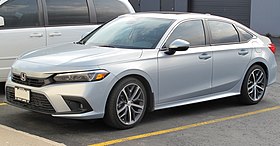2023 Honda Accord, All you want to know about a Great Car
2023 Honda Accord: Everything We Know About the Next-Generation Midsize Sedan
The class-leading four-door is getting a redesign this year. Here’s what to expect.
Honda is having itself a busy year. Fresh off the launch of the new Civic sedan and hatchback, it is about to introduce a new HR-V small SUV, a new CR-V crossover, and this—a new-generation Accord midsize sedan. Just as the CR-V is a juggernaut among compact SUVs, duking it out with the likes of Toyota’s RAV4 for sales, the Honda Accord is a mainstay in the shrinking yet still popular midsize sedan space.
Even the relatively old 2022 model, which was introduced back in 2017 and is about to be replaced by this new 2023 Honda Accord, remains at the top of its class in our Ultimate Car Rankings. It is an achingly competent and satisfying car to own, delivering confident handling, a refined ride, punchy powertrains, and sleek looks inside and out.
What’s New, New Accord?
So, what does changes are in store for the 2023 Accord? If we use the smaller Civic as a template, we can expect Honda to subtly hone everything that’s made the outgoing Accord so great. Literally, just as the newest Civic is based on the previous model, the new Accord will be spun off the current one.
That doesn’t preclude Honda from heavily restyling the Accord, however—again, look no further than the 2022 Civic, which looks nothing like its predecessor despite using the same platform. But we also think given that Honda refashioned the Civic in the Accord’s image, that it likes that image and won’t change it too much for 2023. To give you an idea of what the next Accord might look like, we’ve provided the illustrations here.
Unlike the Civic, which matured from a wild vented, slatted, and creased visage to a cleaner, simpler design that looks vastly more upscale, the Accord already wears a clean, simple design that looks subtly upscale. That means the new model will probably adopt a few details from the Civic, namely its more horizontal shoulder line, squared-off front end, and thinner headlights.
The outgoing Accord’s various curves, arcs, and C-shaped taillights—all holdovers from previous-gen Honda design—will be straightened out, removed entirely, or, in the case of the taillights, slimmed down and simplified.
Though we haven’t rendered the 2023 Accord’s interior, again, look for more Civic inspiration to trickle up. The Civic’s classy full-width dashboard air vent motif, with a mesh treatment blending the actual air vents into a glamorous strip stretching from door-to-door, is almost guaranteed. Ditto the Civic’s more squared-off switchgear, door handles, steering wheel hub, and more. Again, where the old Accord’s door panels and dashboard styling features arcs and swoops, the new one will be predominantly rectilinear.
A touchscreen will again float above the dashboard, but look for the current Accord’s standard split-gauge cluster (half digital, half analog) to give way to a fully digital cluster across the lineup. The roominess of today’s model will carry over to the new one, with perhaps a touch more trunk space carved out of the squarer tail.
Same Platform, Same Engines?
Today’s Accord is relatively lightweight and has a well-sorted suspension that delivers sharp handling, satisfying control feel, and a good ride. Look for minor tweaks here, though the Accord’s curb weight likely will increase slightly (as did the Civic’s), as we anticipate Honda will add sound deadening and more features in a bid to quiet the sedan’s wind and road noise while upping the luxe factor.
Look for the Accord’s trio of powertrains to live on for 2023, albeit with small reworkings for improved fuel economy and power delivery. That means entry-level Accords will retain their turbocharged 1.5-liter I-4 engines and continuously variable automatic transmissions (CVTs), while up-level versions will offer a more powerful turbo 2.0-liter I-4 and a 10-speed traditional automatic.
Finally, the Accord Hybrid and its 2.0-liter I-4 and electric motor combo will return, likely with changes geared toward improving its fuel economy further. Front-wheel drive probably will remain the Accord’s lone option; many competitors, the Toyota Camry included, have begun offering optional all-wheel drive in recent years.
Will It Be Enough?
One question to keep front of mind as the 2023 Honda Accord comes into full view later this year is whether it stays relatively low-key or goes somewhat wild. Many automakers have cut bait and left the midsize segment entirely (as Ford has with its Fusion, and Chevy seems apt to do with its Malibu), and those sedans that remain have grown sexier (i.e. Hyundai Sonata), more athletic (i.e. Mazda6 Turbo), and generally more upscale in a bid to stand out to buyers.
Gone are the days of “boring” midsize sedans playing the role of family sedans without appeal; automakers now see sedan shoppers looking for a more extroverted experience. Hey, if you’re going to give up the practicality of a boxy crossover or a pickup, why not lean into windswept styling that cuts into rear-seat headroom and trunk space and sportier dynamics you can’t get in a similarly priced SUV?
The old Accord was just handsome enough, but Honda’s penchant for restraint might miss the moment these relatively affordable, roomy four-doors are having. All we know is, if the Accord drives anything like the new Civic, while delivering the same if not better quality, it’ll be tough to complain about attractively understated styling.
Accord has been known as one of the best lines from Honda, so it’s just exciting to wait for the updated news related to the upcoming 2023 Honda Accord. Considering that the ride has been set as one of the best luxury sedans in the industry, everyone is curious of what further developments (and work) can Honda do to Accord. For the 2023 model, everyone expects improved luxury and function on the exterior as well as the interior. It would be nice if Honda can include more powerful engine and complete features for the line.
The Expected Redesigned Work
So, what to expect from the redesigned projects for the 2023 model? For a starter, Honda claims that it targets off-the-line abilities and performance by recalibrating the car’s throttle response. It happens to all Accord models. Moreover, there would be a new reminder feature (on the rear seat) that warns the driver to check the door. It is handy in the event one of the doors is opened and no one realizes it. There are more features to expect and wait, although it’s too bad that Honda won’t include the manual six speed transmission into the production anymore.
Exterior Area
Expect the 2023 model to have improved look on the exterior, boosting its luxurious ambiance quite significantly. Rumor has it that Honda is thinking about replacing the chrome blades with black plastic for the 2023 Honda Accord, but we aren’t sure whether it’s true or not. But it seems that the upcoming model will look similar to the current mode, only with the usual facelift recipe. It means that the Accord will likely come with revised rear lights and front end. Since the spy shots have the back side windows covered, it’s likely that it’s getting a new shape too.

Interior Cabin
Premium and luxury are often associated with the Accord. It’s pretty obvious from the interior arrangement. With good combo of classic hues and other colors, the interior feels nice and inviting. However, it would be nice if the new Accord can come with bigger touchscreen display screen and integration to Android Auto and Apple CarPlay.

Engine and Performance
As a premium ride, it’s only natural to expect the best performance from the line; and it includes the engine too. The latest model is able to combine V6 engine with naturally four cylinder unit that can support turbo four engines. When it comes to fuel saving system, both engines are proven to have good system and performance. New safety features would also be included in the line, although there is no further or detailed info about it.

Release Date and Price
This luxury sedan will be likely launched sometime in 2022, set as the 2023 model. With new highlights and updates for the new Accord, expect an increase in the price – although some sources say that the price will be likely the same as the current model. The starting price is said to be around $25,800 for the base (LX) model while the Sport may cost $28,200 and hybrid may cost $27,500 for this 2023 Honda Accord.
Gallery of 2023 Honda Accord: An Even More Improved Vehicle
2023 Honda Accord Review
What is the Accord?
Honda’s long-running Accord has been one our favorite midsize sedans since, well, it was introduced way back in 1976. Now midway through its 10th generation, the Accord continues to impress us with its spacious and premium interior, comfortable ride and fuel-efficient engines. Those engines include 1.5-liter and 2.0-liter turbocharged four-cylinder engines as well as a hybrid powertrain, which we cover in a separate review.
After the Accord’s mild face-lift in 2021, we can’t imagine Honda would change much beyond minor tweaks to feature availability. Certainly we expect nothing drastic for the 2023 model, but we might wager a few bucks on a new special-edition trim level making its way into the lineup.
Also because this current-generation Accord is nearly the end of its run, we wouldn’t be surprised to learn that a new Accord is under development but we wouldn’t expect to see it until the 2024 model year. If you’re in the market for a midsize sedan, we’d recommend also taking a closer look at a couple of the Accord’s closest competitors. The value-packed and well-rounded Kia K5 is a staff favorite as is the stylish and premium-feeling Mazda 6. Stay tuned to this space for all the details about the upcoming 2023 Honda Accord.
2023 Honda Accord, On Youtube
All-new HONDA ACCORD 2023 || Redesigned Luxury SEDAN
2023 Honda Accord – THE NEXT-GENERATION HONDA ACCORD 2023 | DETAIL REVIEW , RUMORS , RELEASE
For more articles:
——————————————————————————————-
FOLLOW US
Cinema Drama News Turkish Drama Lebanon 4 Seasons Lebanon Magazine The Magazine
Honda Civic History
The Honda Civic (Japanese: ホンダ・シビック, Hepburn: Honda Shibikku) is a series of automobiles manufactured by Honda since 1972. Since 2000, the Civic has been categorized as a compact car, while previously it occupied the subcompact class. As of 2021, the Civic is positioned between the Honda Fit/City and Honda Accord in Honda’s global car line-up.
The first-generation Civic was introduced in July 1972 as a two-door coupe model,[2] followed by a three-door hatchback that September. With a 1,169 cc transverse engine and front-wheel drive like the British Mini, the car provided good interior space despite overall small dimensions.
Initially gaining a reputation for being fuel-efficient, reliable and environmentally friendly, later iterations have become known for performance and sportiness, especially the Civic Type R, Civic VTi, Civic GTi and Civic SiR/Si.
The Civic has been repeatedly rebadged for international markets, and served as the basis for the Honda CR-X, the Honda CR-X del Sol, the Concerto, the first generation Prelude, the Civic Shuttle (later to become the Orthia) and the CR-V (which, by extension, was used as the basis for the Honda FR-V).
The Civic is one of the all-time best-selling automobiles in the world, with over 27 million units sold since 1972 as of 2021.
Background
Honda, after establishing itself as a leading manufacturer of motorcycles during the 1950s, began production of automobiles in 1963. Honda introduced its N360 minicar, compliant with Kei car specifications for the Japanese market, for the 1967 model year. The car had a transverse-mounted front-engine, front-wheel-drive (FF) layout, which would be adopted for the later Honda 1300 (1970) and Civic (1972) models.
The Civic gave Honda their first market success competing with manufacturers of standard compact cars, which was a growth segment as sales of kei cars plateaued and waned in the early 1970s.
It was Honda’s first model to have an impact in the export market. It became one of the most influential automotive designs of the 1970s, with the Volkswagen Golf (1974), Ford Fiesta (1976), and Fiat Ritmo (1978) showing similarities as transverse-FF, truncated-trapezoidal hatchbacks occupying a size niche between minicars and compact sedans. The Renault 5 was introduced six months before the Honda Civic which appeared later in July.
Honda would later expand the Civic’s FF-compact design to produce the larger and more upmarket Accord (1976) and Prelude (1978) models. In Japan, the Civic was the first fully modern compact car in the European style, offering a level of prestige never before seen in this class in the market. The Civic quickly inspired Japanese domestic manufacturers to respond in kind, with models like the Mazda Familia AP, Daihatsu Charade, and Mitsubishi Mirage.
Previously a subcompact, since 2000 the Civic has been categorized as a compact car. US EPA guidelines for vehicle size class stipulate a car having combined passenger and cargo room of 110 to 119.9 cubic feet (3,110 to 3,400 L) is considered a mid-size car, and as such the tenth generation Civic sedan is technically a small-end mid-size car, although it still competes in the compact class.
In Japan, as customers increasingly shifted to minivans and compact cars like the Fit, production of the non-hybrid Civic ended in August 2010. However, the Civic was reintroduced into the Japanese market with the launch of the tenth-generation model in 2017.
First generation (1972)
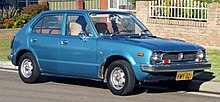

The first-generation Civic was introduced on 11 July 1972, but sold as a 1973 model in Japan. It was equipped with a 1,169 cc (71.3 cu in) four-cylinder water-cooled engine and featured front power disc brakes, reclining vinyl bucket seats, simulated wood trim on the dashboard, as well as optional air conditioning and an AM/FM radio.
The Civic was available as a two- or four-door fastback sedan, three- and a five-door hatchback, as well as a five-door station wagon. Because of the 1973 oil crisis, consumer demand for fuel efficient vehicles was high, and because of the engine being able to run on either leaded or unleaded fuel, it gave drivers fuel choice flexibility over other vehicles.
The CVCC engine debuted in December 1973, with a head design that allowed for more efficient combustion, and as a benefit the CVCC system did not require a catalytic converter or unleaded fuel to meet 1975 Environmental Protection Agency emissions standards for hydrocarbons and carbon monoxide. The Civic was joined by a platform expansion of the three-door hatchback, called the Honda Accord in 1976.
Second generation (1979)


The second-generation Civic was introduced in June 1979 as a 1980 model. It was larger, had a more angular shape, and came with increased engine power. All Civic engines now used the CVCC design, which added a third valve per cylinder; this introduced lean-burn swirl technology. This generation was available with a 1,335 cc (“1300”) engine and with an optional 1,488 cc (“1500”) version; power outputs varied considerably between Japan, Europe, North America, and other markets.
Three transmissions were offered: a four-speed manual (on base models), a five-speed manual, and a two-speed semi-automatic Honda had previously called the “Hondamatic”. The second generation Civic was offered as a three-door hatchback, a four-door sedan, a five-door hatchback and a five-door wagon.
Third generation (1983)

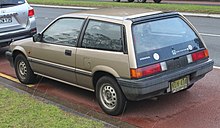
The third-generation Civic was released in September 1983 for the 1984 model year. The separate five-door hatchback and wagon models were merged into a five-door “shuttle wagon” or “wagovan” sometimes referred to colloquially as a “breadbox” because of its appearance, called the Honda Civic Shuttle. An additional two-seat coupe style—labeled CRX—was introduced, noted for its compact dimensions and light weight.
The third generation Civic saw the introduction of the long running four-cylinder D series engine including a new 1.5 L (91.5 cu in) CVCC engine producing 76 HP. 1984 also saw the release of a high-performance Si model for the Japanese market, featuring upgraded suspension and the 1.6 L (97.6 cu in) DOHC ZC engine which was rated at 130 PS (128 HP). Si models were offered in the U.S. as a 3-door Civic Si hatchback and the CRX Si variant with a 91 horsepower (68 kW) fuel-injected SOHC 12-valve engine.
A 4WD configuration with different transmission mounts was introduced for the first time in 1984, and later upgraded in 1987. It delivered a fuel economy of around 28 mpg highway. The 4WD system was push-button operated until improved in 1987 when the rear wheels would engage automatically once the front wheels lost traction.
This new system was called “Realtime” which used a “viscous coupler” connecting two propeller shafts between the front and rear axles. The manual transmission featured a synchronized 6th gear, called “SL”, or “Super-Low”, which was used for high torque at very low speeds.
The “Realtime” idea is still utilized to this day but includes technological improvements since the first system. Starting with 1985, Japanese Civics were now exclusive to Honda Primo, with variants sold at Honda Verno and Honda Clio. A four-door version called the Ballade was built, under agreement, by Mercedes-Benz South Africa, models were 1300, 1500, 1500i and 1600i DOHC 1.6 injection.
Fourth generation (1987)
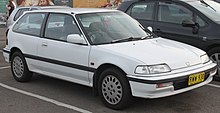

In September 1987, a redesigned Civic was introduced with increased dimensions and a lower hood line. A wide range of models and trim levels were offered for various markets around the world. The most notable of which was the Japanese market SiR (featuring the B16A 1.6-liter DOHC VTEC 4-cylinder engine). All U.S. models featured electronic fuel injection, but carbureted models were still available elsewhere. The fourth-generation saw the introduction of a fully independent rear suspension across the entire model range.
In addition, the Honda CRX continued to be part of the Civic family which included the base model, HF and Si model in the U.S.A / four door version called the Ballade was built, under agreement, by Mercedes-Benz South Africa / models were 1500 16V, 1600i 16V and 1600i 16V DOHC. The first 800 cars produced at the then brand new Honda plant in Alliston, Ontario, Canada were SE model cars.
These Special Edition models included all white side molding that matched the white body and color matched dual mirrors. In the body molding was a wrap around blue stripe. Each car had interior upgrades as well as a chrome-tipped exhaust.
Fifth generation (1991)


Introduced in September 1991 for the 1992 model year, the redesigned Civic featured increased dimensions, as well as more aerodynamic styling. The wagon variant was now only available in the Japanese market where the previous generation wagon was carried over until 1995. The efficiency of the previous HF model was replaced by the VX hatchback which, with an EPA rating of 48/55 MPG, was Honda’s most fuel efficient model sold at the time.
In North America, the Si featured a 1.6-liter SOHC VTEC valve train, whereas the VX featured the VTEC-E. The Japanese Si featured a 1.6-liter DOHC non-VTEC valve train D16A9. Continuing in the sporty tradition of the original Civic SiR, Honda sold several similarly equipped variants of the fifth generation car, still referred to as the Civic SiR, in Japan, Asia and Europe.
In South Africa, MBSA (Mercedes Benz of SA) built the Civic as the Ballade only in 4-door sedan. A special model was the 180i with the B18B4, that was fitted to Ballade models. A new body style was introduced with this generation called the Civic Coupé, based from the Civic Ferio sedan, and was sold in North America, Europe and Japan. The fifth-generation remains popular among tuners and racers alike.
Sixth generation (1995)
Introduced in September 1995 for the 1996 model year, the sixth-generation featured updated styling although less radical than previous redesigns. Suspension and engine options were available along with their first Natural Gas Powered Civic, the GX. In the United States, model year 1996 to 2000 the Civic was sold under the CX, DX, EX, EXR, HX, LX, and for Canada, SE, and Si trims; all base models were made with 1.6-liter 4-cylinder engines. The EX-CX are all SOHC (Honda D engine).
The CX, DX and LX all have SOHC (D16Y7) 4-cylinder engines; whereas the EX has a 1.6L 16-valve SOHC VTEC (D16Y8) engine producing 127 hp (95 kW), and the HX has a D16Y5 VTEC-E engine producing 115 hp (86 kW). The USDM Si and Canadian SiR came with a 1.6L 16-valve DOHC VTEC (B16A2) engine producing 160 hp (119 kW). The first Civic Si coupe EM1 was introduced in 1999 and was produced until 2000.
Europe saw a DOHC 1.6 VTi hatchback and sedan and a DOHC 1.8L engine was available for the Domani related 5-door liftback and estate. In Canada, the Acura EL is based on the Civic, and was replaced by the CSX in 2006.



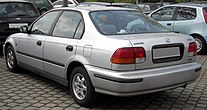
Seventh generation (2000)
The seventh-generation Civic was released in September 2000, for the 2001 model year. While the redesign retained the previous generation’s exterior dimensions, interior space was improved in part by using a flat rear floor thus bumping up Civic to a compact car size segment.
The front suspension was changed from that of a double wishbone to a MacPherson strut, in order to lower costs, as well as allow more engine bay room for the newly introduced Honda K-series engine. Power was also increased on some trim levels. The four main trim levels were DX, LX, EX and HX. The Civic Coupe was no longer sold in Japan starting with this generation.
In North America, coupe and sedan body styles were available, except for the Si (SiR in Canada) which was offered only as a three-door hatchback.[20] The rest of the world received three- and five-door hatchbacks. The Type R was redesigned as well this time using a more powerful i-VTEC engine and using the three-door hatchback body style. This generation saw Honda introduce their first Civic Hybrid, powered by a 1.3-liter engine.[21]





Eighth generation (2005)
The eighth-generation Civic was released in September 2005 in the North American market, for the 2006 model year. For the eighth-generation, Honda split the model into two different platforms, one for sedan and coupe, and one for a hatchback designed primarily for the European market using a simpler rear suspension from the Honda Fit and more aggressive styling.
Although the North American and the Asia-Pacific model slightly differ in front and rear styling, they are mechanically identical. The hatchback is available as a three and five-door. Both Si and Type R trim levels continued although the Japanese and European Type R, while sharing the same engine size, are mechanically different.
In the United States, an improved, sportier version of the Civic Si 4-door tuned by tuner Mugen was offered, featuring cosmetic alterations and changes to the suspension, wheels, slight exterior differences, and exhaust system. A Canadian-only Acura model received a new nameplate, changing from the Acura EL to the Acura CSX.
As of 2006, a total of 16.5 million Civics had been sold worldwide, with 7.3 million of them in the United States.[
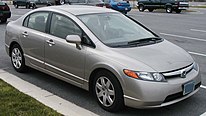




Ninth generation (2011)
The ninth-generation Civic consists of four body styles, which are sedan, coupe, hatchback and station wagon marketed as the Civic Tourer. The latter two makes up for the European-market Civic range built in the UK. The hatchback version forms a basis for a Civic Type R (FK2) model, which was released later in 2015.
The production version of the ninth-generation Civic sedan and coupe first went on sale in the U.S. on April 20, 2011, for the 2012 model year. The model was developed during the height of the global financial crisis, which led Honda to believe that consumers specifically in North America would be willing to forego upscale content and quality in new vehicles as long as they were fuel efficient and affordable.
Following criticisms regarding quality and refinement,[24] Honda updated the Civic with new exterior and interior improvements in late 2012 for the 2013 model year.[25] The ninth-generation Civic was never introduced in Japan, except the 750-unit limited run Civic Type R sold in 2015.
A hybrid version was also available for the sedan model, equipped with a larger 1.5-liter i-VTEC engine that produces 90 hp and 97 lb ft of torque[28] and a lithium-ion battery, is rated at 44 mpg‑US (5.3 L/100 km; 53 mpg‑imp) in combined city and highway EPA test cycle, an improvement of 3 mpg‑US (3.6 mpg‑imp) over the previous generation hybrid.[29]




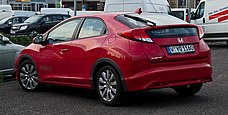
Tenth generation (2015)
Based on an all-new Honda compact global platform, the tenth-generation Civic marked the unification of the Civic range globally. Honda targeted the Civic range at the key U.S. market, resurrecting its once-discarded “lead-country” system which calls for developing a model specifically for its main targeted market but selling it in other regions as well.
As the result, Honda ceased making a smaller, dedicated version for the European market. Instead, the Swindon plant in UK produced a five-door hatchback version of the globally-marketed Civic for international markets.
The sedan model was first unveiled in the U.S. in September 2015, for the 2016 model year. The tenth-generation Civic features a new fastback exterior design, with the rear C-pillar flowing into the tailgate. The front of the car features a new chrome wing design that flows across the top of the headlamps.
Civic body styles include sedan, coupe, five-door hatchback, while performance models include Si trims and Type R models. The hatchback version saw its re-introduction in the North American market for the first time since 2000, along with the first Type R model ever sold in the region, both imported from the UK.
The interior of the new Civic likewise features major design changes. Unlike the split bi-level speedometer and tachometer of its predecessor, tenth-generation Civic consolidates these instruments into an optional “Driver Information Interface” incorporating a customizable 7-inch LCD screen positioned directly behind the steering wheel and in the driver’s line of sight. Several model received an instrumentation that consists of a large analog tachometer that surrounds a digital speedometer and other digital displays.

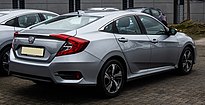



Eleventh generation (2021)
The eleventh-generation Civic sedan was revealed as a prototype on November 17, 2020.[48] Its first official image was revealed on April 14, 2021. It was fully revealed on April 28, 2021[49] and released on June 16, 2021, as a 2022 model in North America. The liftback variation (marketed as “Civic Hatchback”) was unveiled on June 23, 2021, for North America and Japan. A coupe version is not offered due to its declining sales.
The eleventh-generation Civic sedan is not sold in Japan and Australia because of low demand of its predecessor.
-
Rear view (sedan)
-
Civic Hatchback
-
Rear view (Civic Hatchback)
-







